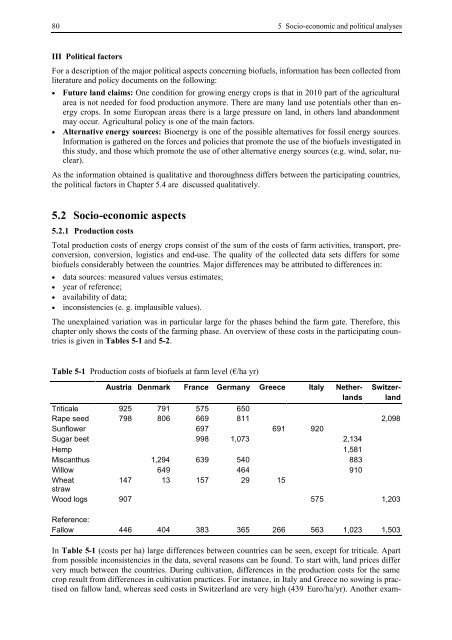BIOENERGY FOR EUROPE: WHICH ONES FIT BEST?
BIOENERGY FOR EUROPE: WHICH ONES FIT BEST?
BIOENERGY FOR EUROPE: WHICH ONES FIT BEST?
Create successful ePaper yourself
Turn your PDF publications into a flip-book with our unique Google optimized e-Paper software.
80 5 Socio-economic and political analyses<br />
III Political factors<br />
For a description of the major political aspects concerning biofuels, information has been collected from<br />
literature and policy documents on the following:<br />
• Future land claims: One condition for growing energy crops is that in 2010 part of the agricultural<br />
area is not needed for food production anymore. There are many land use potentials other than energy<br />
crops. In some European areas there is a large pressure on land, in others land abandonment<br />
may occur. Agricultural policy is one of the main factors.<br />
• Alternative energy sources: Bioenergy is one of the possible alternatives for fossil energy sources.<br />
Information is gathered on the forces and policies that promote the use of the biofuels investigated in<br />
this study, and those which promote the use of other alternative energy sources (e.g. wind, solar, nuclear).<br />
As the information obtained is qualitative and thoroughness differs between the participating countries,<br />
the political factors in Chapter 5.4 are discussed qualitatively.<br />
5.2 Socio-economic aspects<br />
5.2.1 Production costs<br />
Total production costs of energy crops consist of the sum of the costs of farm activities, transport, preconversion,<br />
conversion, logistics and end-use. The quality of the collected data sets differs for some<br />
biofuels considerably between the countries. Major differences may be attributed to differences in:<br />
• data sources: measured values versus estimates;<br />
• year of reference;<br />
• availability of data;<br />
• inconsistencies (e. g. implausible values).<br />
The unexplained variation was in particular large for the phases behind the farm gate. Therefore, this<br />
chapter only shows the costs of the farming phase. An overview of these costs in the participating countries<br />
is given in Tables 5-1 and 5-2.<br />
Table 5-1 Production costs of biofuels at farm level (€/ha yr)<br />
Austria Denmark France Germany Greece Italy Nether- Switzer-<br />
lands land<br />
Triticale 925 791 575 650<br />
Rape seed 798 806 669 811 2,098<br />
Sunflower 697 691 920<br />
Sugar beet 998 1,073 2,134<br />
Hemp 1,581<br />
Miscanthus 1,294 639 540 883<br />
Willow 649 464 910<br />
Wheat<br />
straw<br />
147 13 157 29 15<br />
Wood logs 907 575 1,203<br />
Reference:<br />
Fallow 446 404 383 365 266 563 1,023 1,503<br />
In Table 5-1 (costs per ha) large differences between countries can be seen, except for triticale. Apart<br />
from possible inconsistencies in the data, several reasons can be found. To start with, land prices differ<br />
very much between the countries. During cultivation, differences in the production costs for the same<br />
crop result from differences in cultivation practices. For instance, in Italy and Greece no sowing is practised<br />
on fallow land, whereas seed costs in Switzerland are very high (439 Euro/ha/yr). Another exam-

















